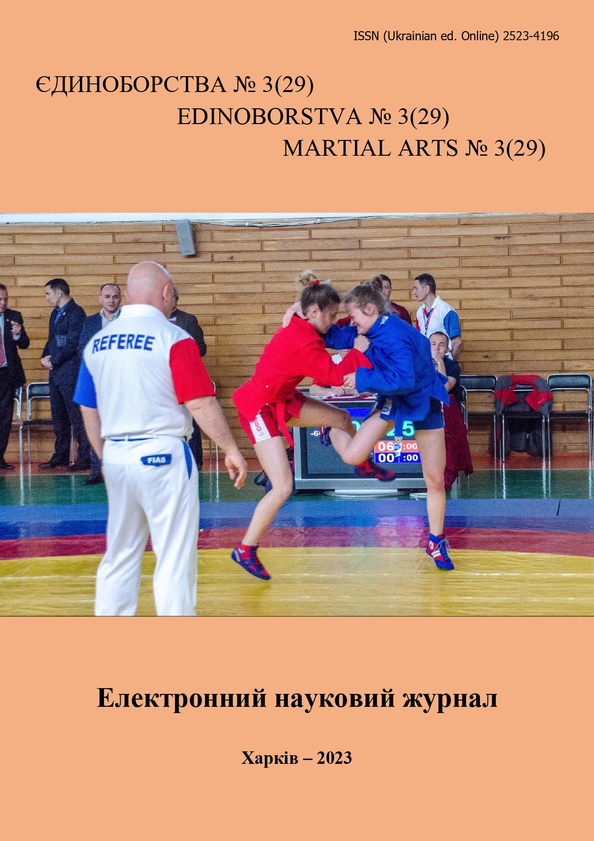Investigation of the reaction to a moving object in taekwondo athletes
DOI:
https://doi.org/10.15391/ed.2023-3.01Keywords:
martial arts, taekwon-do, sensorimotor reactions, testing, competitionAbstract
Purpose: to define features of reaction to a moving object in taekwondo. Material and Methods. The following research methods were used: analysis of scientific and methodological literature and Internet sources; pedagogical observation; psychophysiological measurements; methods of mathematical statistics. Results: the use of non-parametric Mann-Whitney criterion confirmed that the average reaction time for the whole test in older sportsmen is significantly better than in junior sportsmen by 31,39 % (U=5, p<0,01). When analyzing the directionality of the processes of excitation or inhibition, it was found that older athletes had better reaction accuracy than junior athletes (U=10,5, p<0,05). In both groups sportsmen reacted mainly prematurely, but junior taekwondoists reacted prematurely more often by 17,66 % (U=4, p<0,01). According to Spearman's correlation coefficient between the age of sportsmen and the obtained indicators of measurement the following results were obtained: between reaction time and age in the 1st group r=0,26, in the 2nd group r=-0,37 (p>0,05), between exact reactions and age in the 1st group r=0,32, in the 2nd group r=0,68 (p<0,05). According to the analysis of the results of the second measurement, there is no sufficient evidence that the average values of reaction time in both groups before and after the competition are different. After the competition, the accuracy of reactions in sportsmen from group 1 is lower by 31,1 % than before the competition (U=11, p<0,05). In group 2 there were no statistically significant differences between the indicators of reaction accuracy before and after competitions. The U-criterion did not show statistically significant difference between the direction of processes of excitation and inhibition in group 1 and group 2 before and after competitions. In the 1st group Spearman's coefficient testifies to the absence of statistically significant (p>0,05) correlation between the performance of sportsmen at competitions and average reaction time (r=-0,31). The similar correlation was established in group 1 between results at competitions and accuracy of reactions, r=-0,25 (p>0,05). In group 2, there was also no statistically significant (p>0.05) correlation between the results of the competition and the average reaction time (r=0,52). There is a statistically significant strong inverse correlation (p<0,05) in group 2 between the results of athletes in competitions and their reaction accuracy (r=-0,83). Conclusions. The results of the analysis of the reaction to a moving object indicate that there are significant differences between the groups. Highly skilled, older athletes have better ability to adjust nervous processes and shorter reaction times to a moving object. There is a statistically significant correlation between athletes' performance in competitions and the accuracy of their reactions. Indicators such as reaction speed and accuracy are important in taekwondo competitions and should be studied in future research.
References
Вовканич, Л.О., Дунець-Лесько, А.М., Пенчук, А.П., & Качмар, П.О. (2015). Особливості сенсомоторних реакцій спортсменів різних спортивних спеціалізацій. Фізична активність, здоров`я і спорт, 2(20), 17-26.
Макаренко, М.В., & Лизогуб, В. С. (2015). Реакція на рухомий об’єкт як тест на визначення зрівноваженості нервових процесів. Вісник Національного університету оборони України, 1 (44), 142-147.
Радченко, Ю.А. (2009). Взаємозв’язок між психофізіологічними функціями і часом виконання технічних дій у висококваліфікованих. Педагогіка, психологія та медико-біологічні проблеми фіз. виховання і спорту, (1), 114–118.
Романенко, В.В., & Веретельникова, Н.А. (2020). Методика оцінки моторної функціональної асиметрії одноборців. Єдиноборства, 1(15), 67–77.
Тропін, Ю.М., Романенко, В.В., & Латишев, М.В. (2021). Взаємозв’язок рівня прояву сенсомоторних реакцій з показниками фізичною підготовленістю у юних таеквондистів. Єдиноборства, 2, 93-104.
Blumenstein, B., Lidor, R., & Tenenbaum, G. (2005). Periodization and planning of psychological preparation in elite combat sport programs: The case of judo. International journal of sport and exercise psychology, 3(1), 7-25.
Borysiuk, Z., & Cynarski, W.J. (2009). Reaction time and movement time, types of sensorimotor responses and fencing tempo. Ruch dla Kultury / Movement for Culture, (9), 189-200.
Borysiuk, Z., & Waskiewicz, Z. (2008). Information processes. Stimulation and perceptual training in fencing, Journal of Human Kinetics; doi: 10.2478/v10078-008-0005-y.
Borysiuk, Z., Petrynski, W., & Cynarski, W.J. (2010). Reaction time, movement time and EMG signals as indicators of anticipation processes in elite fencers, Antropomotoryka, (51), 15-23.
Chernenko, N., Lyzohub, V., Korobeynikov, G., Potop, V., Syvash, I., Korobeynikova, L., & Kostuchenko, V. (2020). Relation between typological characteristics of nervous system and high sport achieving of wrestlers. Journal of Physical Education and Sport, 20(3), 1621-1627.
De la Fuente, A., & Gómez-Landero Rodríguez, L.A. (2019). Motor differences in cadet taekwondo athletes according to competition level. Revista Internacional de Medicina y Ciencias de la Actividad Fisica y del Deporte, (73), 63–75.
Kalina, R.M. (2005). Empirical basic for predicting-success in combat sport and self-defence. Kinesiology, 37 (1), 64–73.
Koopmann, T., Krause, D., Steffemann-Weinrich, Y., & Baumeister, J. (2016). Mental Rotation of Tactical Instructions in Basketball Increases Processing Demand and Execution Inaccuracy. Research Quarterly for Exercise and Spor, 87(S1), S98.
Korobeynikov, G., Korobeinikova, L., Mytskan, B., Chernozub, A., & Cynarski, W.J. (2017). Information processing and emotional response in elite athletes. Journal of Martial Arts Anthropology, 17(2), 41-50
Podrigalo, L., Romanenko, V., Podrihalo, O., Iermakov, S., Huba A., Perevoznyk, V., & Podavalenko, O. (2023). Comparative analysis of psychophysiological features of taekwondo athletes of different age groups. Pedagogy of Physical Culture and Sports, 27 (1), 38–44.
Quinzi, F., Modica, M., Berchicci, M., Bianco, V., Perri, R.L., & Di Russo, F. (2022). Does sport type matter? The effect of sport discipline on cognitive control strategies in preadolescents. International Journal of Psychophysiology, 177, 230–239.
Shiyan, V. (2013), Methods for improvement of wrestlers’ motor skill stability, International Journal of Wrestling Science; doi:10.1080/21615667.2013.10878976.
Кorobeynikov, G. (2015). The cognitive functions and slyles of ight in elite female judokas. Рhysical activity health and sport, (19), 31-37.
Мouelhi, G.S. (2006) Simple and choice reaction times under varying levels of physical load in high skilled fencers. The Journal of Sports Medicine and Physical Fitness, 46 (2), 335–343.
Тunnemann, H. (2013) Evolution and adjustments for the new rules in wrestling. International Journal of Wrestling Science, 3 (2), 94–105.













